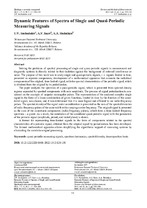| dc.contributor.author | Suchodolov, U. V. | |
| dc.contributor.author | Isaev, A. V. | |
| dc.contributor.author | Sheinikau, A. A. | |
| dc.coverage.spatial | Минск | ru |
| dc.date.accessioned | 2022-07-06T11:51:39Z | |
| dc.date.available | 2022-07-06T11:51:39Z | |
| dc.date.issued | 2022 | |
| dc.identifier.citation | Suchodolov, U. V. Dynamic Features of Spectra of Single and Quasi-Periodic Measuring Signals = Спектральное представление измерительных одиночных и квазипериодических сигналов / U. V. Suchodolov, A. V. Isaev, A. A. Sheinikau // Приборы и методы измерений. – 2022. – Т. 13, № 2. – С. 128-138. | ru |
| dc.identifier.uri | https://rep.bntu.by/handle/data/113852 | |
| dc.description.abstract | Solving the problems of spectral processing of single and quasi-periodic signals in measurement and diagnostic systems is directly related to their isolation against the background of external interference or noise. The purpose of this work was to study single and quasi-periodic signals, i. e. signals limited in time, presented as separate components; development of a mathematical apparatus that connects the individual components of the original, time-limited signal, with the spectral characteristics of the periodic signal, which is obtained from the original by its periodization. The paper analyzes the spectrum of a quasi-periodic signal, which is presented from spectral density regions separated by spectral components with zero amplitude. The process of signal periodization is considered on the example of unipolar rectangular pulses. The representation of the analyzed complex single signal in the form of a linear combination of given functions, limited in time by the duration of the considered signal, was chosen, and it was determined that it is most logical and efficient to use radio-frequency pulses. The spectral density of the signal under consideration is presented as the sum of the spectral densities of radio-frequency pulses of the same width with a varying carrier frequency. The original signal is presented as the sum of the constituent components (radio-frequency pulses), which form a time-limited frequency spectrum – a quastr. As a result, the correlation of the considered quasi-periodic signal with the parameters of the periodic signal (amplitude, period, and initial phase) is shown. A format for representing time-limited signals in the form of components related to the spectral characteristics of a periodic signal, obtained from the original signal by periodization, has been developed. The formed mathematical apparatus allows simplifying the algorithmic support of measuring systems by eliminating the correlation signal processing. | ru |
| dc.language.iso | en | ru |
| dc.publisher | БНТУ | ru |
| dc.title | Dynamic Features of Spectra of Single and Quasi-Periodic Measuring Signals | ru |
| dc.title.alternative | Спектральное представление измерительных одиночных и квазипериодических сигналов | ru |
| dc.type | Article | ru |
| dc.identifier.doi | 10.21122/2220-9506-2022-13-2-128-138 | |
| local.description.annotation | Решение задач по спектральной обработке одиночных и квазипериодических сигналов в системах измерения и диагностики непосредственно связанно с их выделением на фоне внешних помех или шумов. Целью работы являлось исследование одиночных и квазипериодических сигналов, т. е. сигналов, ограниченных во времени, представленных в виде отдельных компонент; разработка математического аппарата, связывающего отдельные компоненты исходного, ограниченного во времени сигнала, со спектральными характеристиками периодического, который получен из исходного путём его периодизации. В работе проведён анализ спектра квазипериодического сигнала, который представлен из участков спектральной плотности, разделённых спектральными составляющими с нулевой амплитудой. Рассмотрен процесс периодизации сигнала на примере однополярных прямоугольных импульсов. Выбрано представление анализируемого сложного одиночного сигнала в виде линейной комбинации заданных функций, ограниченных по времени длительностью рассматриваемого сигнала. Определено, что наиболее логично и эффективно в качестве линейной комбинации заданных функций использовать радиоимпульсы. Представлена спектральная плотность исследуемого сигнала в виде суммы спектральных плотностей радиоимпульсов той же длительности с изменяющейся несущей частотой. Исходный сигнал представлен как сумма составляющих компонент (радиоимпульсов), которые формируют ограниченный во времени частотный спектр – квастр. В результате показана корреляция рассматриваемого квазипериодического сигнала с параметрами периодического сигнала (амплитудой, периодом и начальной фазой). Разработан формат представления ограниченных во времени сигналов в виде компонент, связанных со спектральными характеристиками периодического сигнала, который получен из исходного путём его периодизации. Сформированный математический аппарат позволяет упростить алгоритмическое обеспечение измерительных систем за счёт исключения корреляционной обработки сигнала. | ru |

